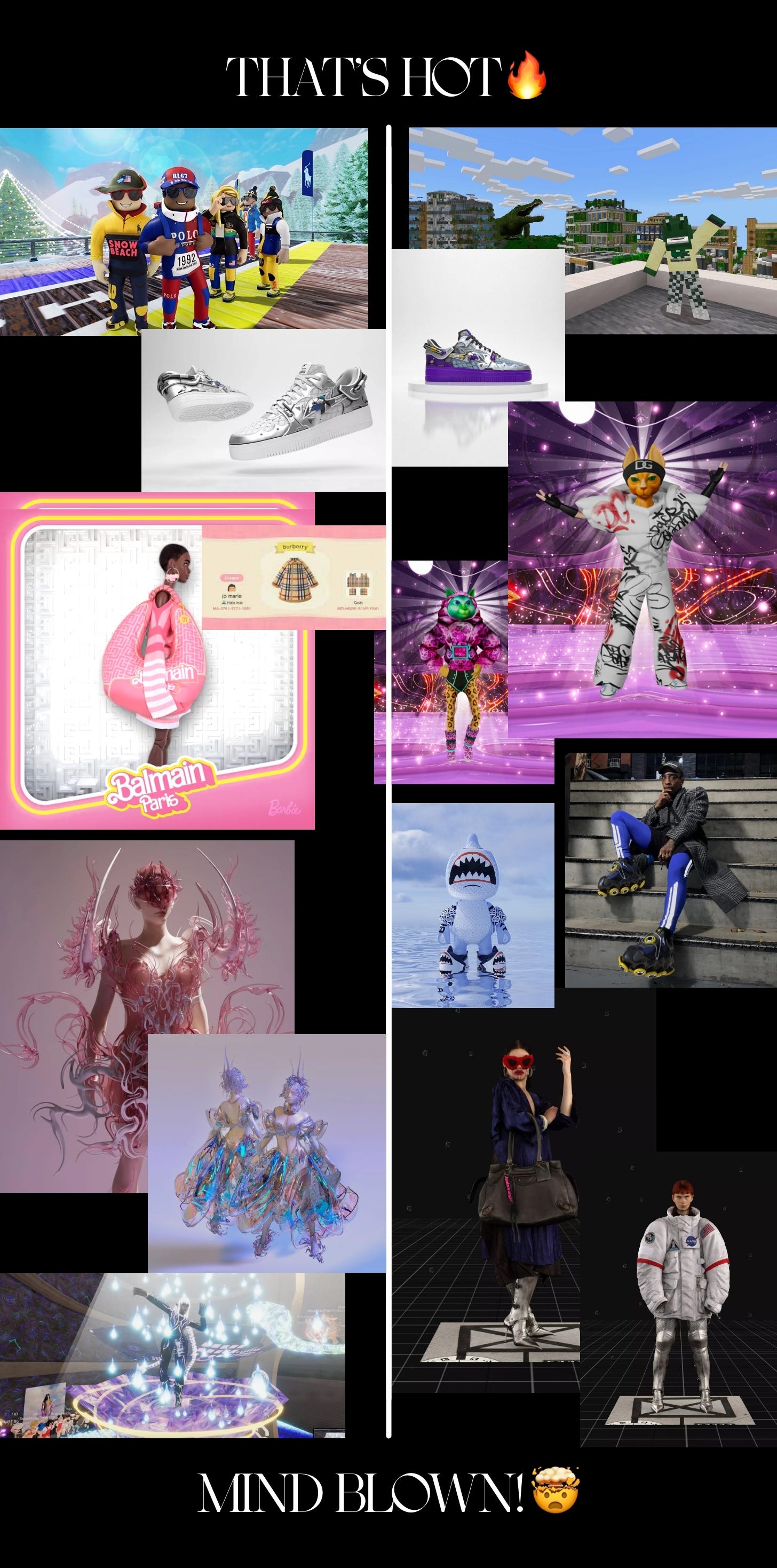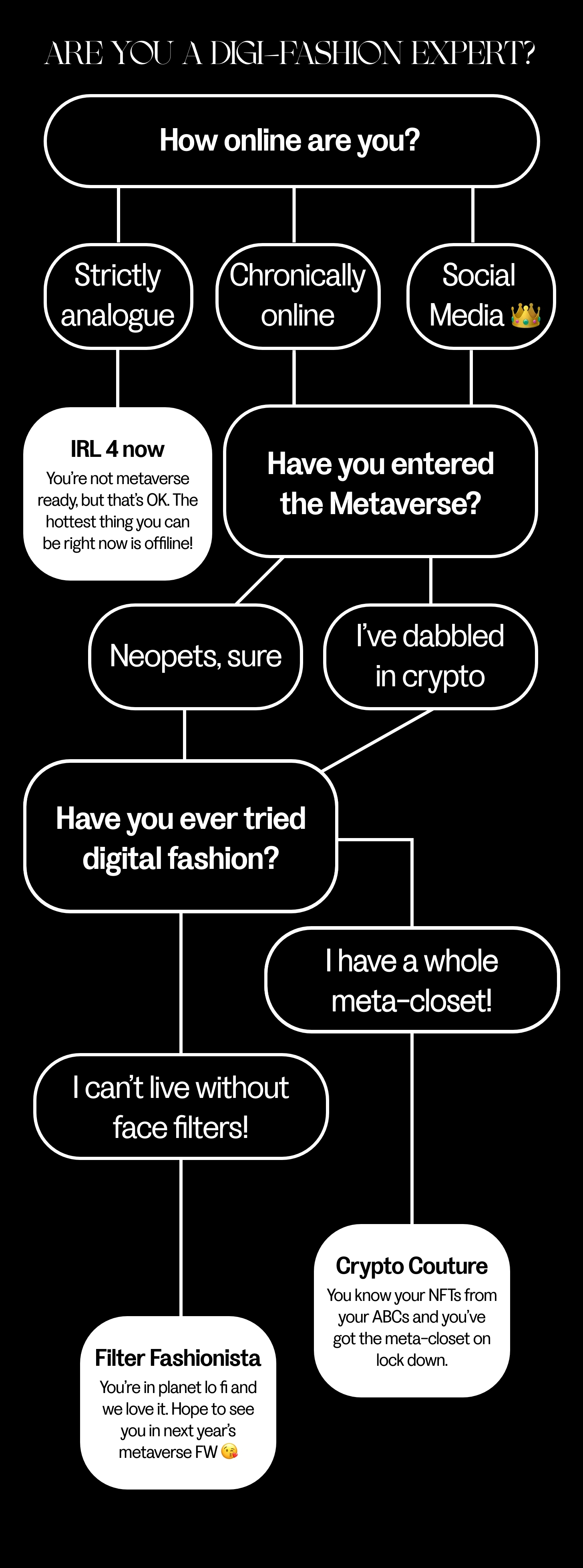Whether you’re actually in the metaverse or not, it feels inescapable. Recently Decentraland’s Metaverse Fashion Week promised an opportunity for brands to “break free of the constraints of reality”. And so, there I was, basking in the glow of my iMac, ready to momentarily abandon my corporeal.
Admittedly, I didn’t stick around long enough to see Grimes performing for Philipp Plein or Dolce & Gabbana's flying models emerging from lotus flowers, but plenty of people did – with Decentraland reporting 108,000 unique attendees. Post-event reports were optimistic, if a little frustrated – listing setbacks like glitches and a Web1.0 feel.
Although it can feel like it did – the metaverse didn’t escape from some dystopian vacuum to wreak havoc on unsuspecting Luddites. For as long as I can remember, I’ve been chronically online. As avatar Ashleigh, I roamed around The Palace in the late 90s and early 00s, interacting with other players, but mostly styling my dollz outfits and dreaming of recreating them IRL. In my late teens, Second Life threatened to suck us all through our screens and ruin the sanctity of marriage.
We no longer bat an eyelid when digital influencers like Lil Miquela land major campaigns with Calvin Klein or that AR face filters have made us forget what we actually look like, and we’ve finally wrapped our tongues around the word ‘phygital’. The pandemic pushed us into new forms of escapism, wading deeper into digital worlds where in-app purchases, like skins, were second nature. While these might seem disparate, they’ve chewed themselves up and spat out a vibe shift: digital fashion. As Lady PheOnix says: “We know that everyone will have an avatar in the future. Those who want to be fashionable IRL also want to be fashionable in the metaverse.”
The Sims players were already bootlegging knock-off Gucci bedding (the fashion house later released an Off The Grid collection for The Sims 4 in late 2020) before Moschino unveiled its physical and digital collection collaboration of plumbob patterned swimsuits and glitchy graphic bags in 2019. That same year, League of Legends partnered with Louis Vuitton to design its Summoner’s Cup trophy, skins, and other in-game digital assets – which sold out within an hour.
In the early wtf days of the pandemic, Marc Jacobs dropped six adorbs fits into Animal Crossing just to let us feel something. Since then, Fortnite has collaborated with Nike, Moncler, and Balenciaga, respectively, each designing their ready-to-battle collections. In August 2021, Burberry blew up in Blankos Block Party, and in February this year, Gucci – an early pioneer with its Virtual 25 sneaker – drew its line in The Sandbox. However, if I were to name all of the toes being dipped in this digital pool, this would be a much longer newsletter than promised.
But lest we forget, the native digital fashion brands. The Fabricant sold the first NFT dress in May 2019 for $9,500 USD, co-designed with artist Johanna Jaskowska, creator of the notorious Beauty3000 face filter. There’s also Xydrobe, who famously teamed up with JW Anderson to sell the digital version of the spring 2020 cardi worn by Harry Styles for – depending on ETH’s market health that day – more than £5k. And RTFKT, the digital sneaker house selling virtual kicks for upwards of $1,500 a pair – and often re-selling at four times that – which Nike acquired last December. Digital artists like Stephy Fung are also designing and teaching live on platforms like Twitch, where they can collaborate with, as well as learn from, their followers.
Companies like Tokens.com are already dropping millions of dollars on real estate space in Decentraland, but brands have so far been tentative, with the exception of adidas who recently invested in a plot of land in The Sandbox. Though its plan remains under wraps, in January, Business of Fashion published an article that predicted the development of digital shopping districts that likened their potential to the “virtual version of Rodeo Drive”.
While it’s unlikely we’ll be burning our wardrobes to the ground and going full crypto couture – digital fashion will be an extension of our style rather than an overhaul of it.
Right now, it’s all a little aesthetically confused – emerging from the battlefields of Fortnite or the mythical land of Blankos Block Party, or fighting for the spotlight in a series of headline-grabbing drops. The first this, the most expensive that.
But as digital fashion is embedded into the fabric of our every day, styles will reflect a wider variety of personalities – D2A (Direct-to-Avatar) is being touted as the next D2C. After all, it’s genderless, sizeless, and fits seamlessly to all body types. After two years of dressing down, we’re craving the chance to reclaim who we are, were, or want to be, and style has always been a fun bedfellow for self-expression.
Imagine the impact that zero materials, zero waste, and zero packaging could have on a burning planet. For the NFT naysayers, this summer, Ethereum will finally shift from PoW to PoS, meaning: digital fashion minted as NFTs on the blockchain will use ~99.95% less energy than they currently do.
For influencers whose bottom dollar depends on ever-changing outfits, digital fashion offers a more cost-effective, sustainable option for keeping up with the Insta Baddies. For the indecisive shopper (me), it could also ease the weight of our carbon footprint as we cycle through buying, trying on, hating everything, and then sending it all back – ad nauseam. The secondary market will be crucial too, and just like we buy, trade, and sell on platforms like Depop, we will do the same with digital garms.
If all this seems like a lot to take in, let’s remember when Bill Gates appeared on David Letterman. The year was 1995, and a younger Bill explains this “internet thing” to a younger and increasingly bemused David.
This is David. Don’t be like David.
🔥🔥🔥The Morning View🔥🔥🔥
The opportunities within digital fashion are huge, and experts predict the market for “skins” in video games will hit $50 billion USD by 2022. Whereas 50 per cent of US Consumers are interested in purchasing a digital asset in the next 12 months.
While we’re still swimming in uncharted water, first mover brands in this space have a chance to win big, remember, adidas line of NFTs earnt them $22 million in sales in one afternoon.
But being a first mover doesn’t mean you rush blindly into the digi-sphere. Here are four tips for metaverse strategies.
🤝 Understand where your audience is at – meet them there. E.g. do your audience love gaming? Meet them in Fortnite. Are they still predominantly social? Lean into AR filters.
🧠 Tap into your audience mindset – what characteristics do they have that translate to the metaverse? E.g. Streetwear brands can tap into the drop mindset of their audience to create NFTs with scarcity value. It’s clear that leading brands such as Nike see the potential.
🥧 Slice the relevant part of the crypto-pie. E.g. If you’re a luxury brand operating in a space with a booming resale market, where fraud and fakes are ever paramount for consumers, employing blockchain technology in transactions can be a no brainer.
🤸♀️ Be playful and push boundaries. E.g. Use this as your space to play, free of limitations of the real world. What does your brand look like when you dream big?






